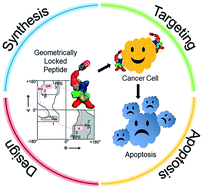Peptide-based delivery vectors with pre-defined geometrical locks†
Abstract
Design of peptide-based targeted delivery vectors with attributes of specificity and selective cellular targeting by fixing their topology and resulting electrostatic fingerprint is the objective of this study. We formulated our peptide design platform by utilizing the possibilities of side-chain induced geometric restrictions in a typical peptide molecule. Conceptually, we locked the conformation of the RGD/NGR motif of tumor homing peptides (THPs) by mutating glycine in these motifs with D-proline and tailed the peptides with a syndiotactic amphipathic segment for cellular penetration. The designed peptides were synthesized, characterized, and tested in vitro on various cell lines, including breast cancer (MDA-MB-231), cervical cancer (HeLa), osteosarcoma (U2-OS) and non-cancer mammary epithelial cells (MCF-10A), by flow cytometry and confocal microscopy. The results showed differential cellular uptake in different cell types, as a result of the distinct electrostatic fingerprint encoded in their design. The uptake of serum pre-treated peptides by cells reveals the retention of peptide activity even after the incubation with serum. In addition, peptide–methotrexate (MTX) conjugates compared to the methotrexate drug showed enhanced apoptotic cell death in MTX-resistant MDA-MB-231 cells, indicating the increase in MTX bioavailability.



 Please wait while we load your content...
Please wait while we load your content...